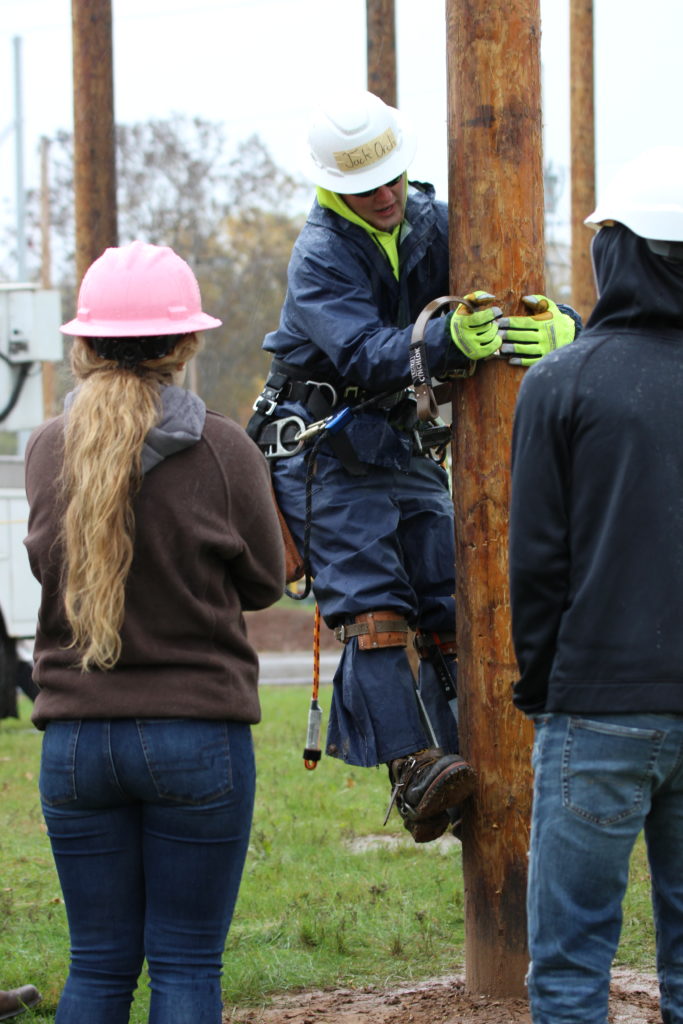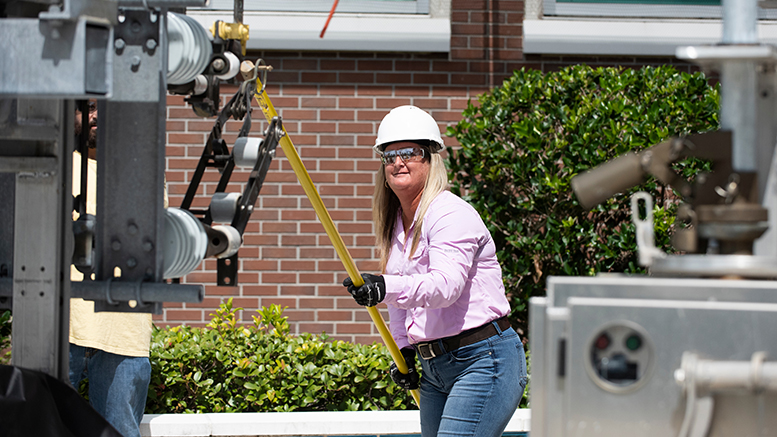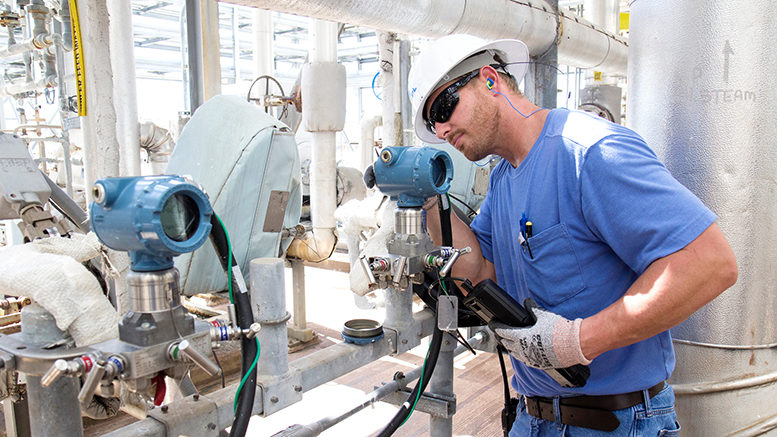Climate-related disasters like hurricanes, wildfires or the extreme cold that took down most of Texas’ electrical grid last month present challenges for energy-related companies and, relatedly, the community colleges who train their future workforce.
The Biden administration’s 13-figure infrastructure spending proposals, which have yet to take legislative form but seem likely to contain significant investments in energy-related infrastructure aimed at combating the effects of climate change, will require two-year schools to tweak and retool their programs as needed to produce solutions to those challenges.
“From increasing enrollment due to new employment opportunities, to incorporating advances in technology into the curriculum, community colleges are well-positioned to meet current and future clean energy workforce needs,” said Jeffrey Rafn, president of Northeast Wisconsin Technical College (NWTC), based in Green Bay, and home of the Great Lakes Energy Education Center, a learning facility designed for zero-net energy.

The Biden proposal, aimed to reduce carbon emissions and build green infrastructure, could include specific spending on energy-efficient buildings, green transit, electric vehicle charging stations, upgrades to the electric grid and the power sector generally, and climate-related research and development into products such as electric vehicle batteries. The end goal: 10 million clean energy jobs, along with a carbon-free power sector by 2035 and net-zero greenhouse gas emissions by 2050.
If anything like the current proposal passes, “It will have a significant effect on the number of educated people who will be needed in these areas,” said Amy Kox, dean of trades and engineering technologies at NWTC, who previously served as associate dean for energy programs. “Solar, and wind, and renewable energy pieces, which is what people think about the most, need infrastructure there to support them. Running the electrical, from generation to the business or home, needs to be there as well. It will affect the entire energy workforce in its implementation.”
Kevin Cooper, dean of advanced technology at Indian River State College in Fort Pierce, Florida, agrees that the package would be transformative.
“The federal package is going to put a lot of incentive to move to renewables,” he said. “Coal workers and some traditional fossil fuel workers will be out of work, and we’re going to have to add other elements to their skillset, so they can get back up to speed quickly. Colleges across the country are going to need quick-response training: What puts a student to work quickly, but still leads to a degree?”
Ready to roll
Although Louisiana hasn’t experienced anything quite like the Texas power outages on a statewide level, hurricanes and tropical storms pound the state every year, underscoring the importance of programs like the electrical lineworker track at South Louisiana Community College (SLCC), said Jermaine Ford, vice president, workforce and economic development.
“Look what happened when we had Hurricane Delta back in October – we had some regions hit very, very hard. Some of them are still getting back up,” he said. “They’re [electrical linemen] the first crew to go out when a natural disaster strikes. It’s very dangerous conditions that these men and women are going into to get power restored. … I’m proud of the utility companies here in Louisiana that have been able to get power restored very quickly.”
“That is the workforce we’re training,” Kox said of disasters like the Texas power outages. “When things like that happen, whether to an existing infrastructure system or because of a hurricane, these are the folks that come in and make sure your power is on, and you have heat and cooling. I don’t know if there’s much more essential of a workforce description than that.”
Indian River, in the midst of starting a lineworker program of its own, sees the need to create more resilient, cleaner, sustainable micro-grids that lower bills and can more easily offset peak loads to guard against outages, Cooper said.
“What’s needed in that workforce base is a different skill set than currently exists,” he said.
A growing demand
Community colleges with energy-related infrastructure programs say they will be ready to retrain and upskill workers to face the challenges of Mother Nature and the potential opportunities from the federal package.
South Louisiana (SLCC), in an area that faced a battery of tropical storms last year, started its power lineman program a year and a half ago, designed in concert with utility companies and local contractors, Ford said. Lineworkers earn an average of $72,000 per year, and that figure is expected to grow, Ford said.
To date, four cohorts have gone through the program, and everyone who sought employment in the sector has found it.
“It’s so vast – the need is so great. We’re talking about an aging workforce,” Ford said. “They’re getting the right credentials to go into an industry and make an immediate impact from day one.”
Although the field has taken hits in recent years, SLCC also continues to offer an oil-and-gas program, which teaches a broad-based curriculum about working in the field, and Ford expects that field – and his program – to revive over time.
“The downturn in oil and gas has caused us to pivot and form programs like electrician, HVAC and linemen,” he said. “Our finger is on the pulse, working with industry to determine where they’re going.”
It’s a bit early to say where industries like solar might go in the coming years, he added.
‘The large canopies’
NWTC recently received a National Science Foundation (NSF) grant to create a utilities and energy coordination network, which will help spur conversations and synergy among local utilities, contractors and the college and its peer institutions.
“We think that’s a great model we can help other colleges with,” Kox said. “This network is about connecting us all.”
Community college programming pointed at the energy industry will continue to grow, whether targeted to renewables or more traditional areas like natural gas, she said. NWTC has programs in what Kox refers to as “three of the large canopies.” These are distribution of energy, such as line worker and gas utility running and service; generation, including solar energy, wind and nuclear, the latter two in partnership with another area school; and conservation, including energy management.
Through a referendum three years ago, NWTC built the Great Lakes Energy Education Center, which offers customized corporate training to the incumbent workforce. The college also expanded its apprenticeship programs, and the solar program has grown in demand due to the emphasis on renewables, Kox said.
“That renewable piece is what’s out there in front of the media,” she said. “The infrastructure has to be there to support taking that generation and getting it to where it needs to go. That bodes well for lineworkers.”
Students can take an associate-degree program that costs less than $15,000 and find a job that pays more than $60,000 per year, Kox noted.
“The opportunities are out there,” she said. “Community colleges are a great place to start.”
Quickly shifting gears
Indian River (IRSC), a National Center for Excellence for NSF, started to focus on nuclear energy about a decade ago, then after saturating that market expanded into fossil fuel generation, transmission and substations. The latter program graduates 25 students annually who get “local, high-paying jobs,” Cooper said.
The college also set up a facility that replicates a power plant and rapidly upskills about 2,000 incumbent workers per year. The lineworker program coming online will take nine months and graduate workers into jobs that pay an average of $80,000 to start, he said. And IRSC offers a program to build the micro-grid that covers solar, energy storage like batteries, and generation.
“It’s really exciting, in terms of creating a curriculum and helping other schools create a curriculum that covers three unique disciplines together and provides a technician with everything he needs to do his job,” Cooper said. “If you drain the solar, and then the batteries, you still have generation. Let’s say you’re a hospital – you can turn on the micro-grid and have resiliency.”
That probably sounds terrific to a lot of medical staffers in Texas – and is the kind of thing that could become more scalable in the years to come.


